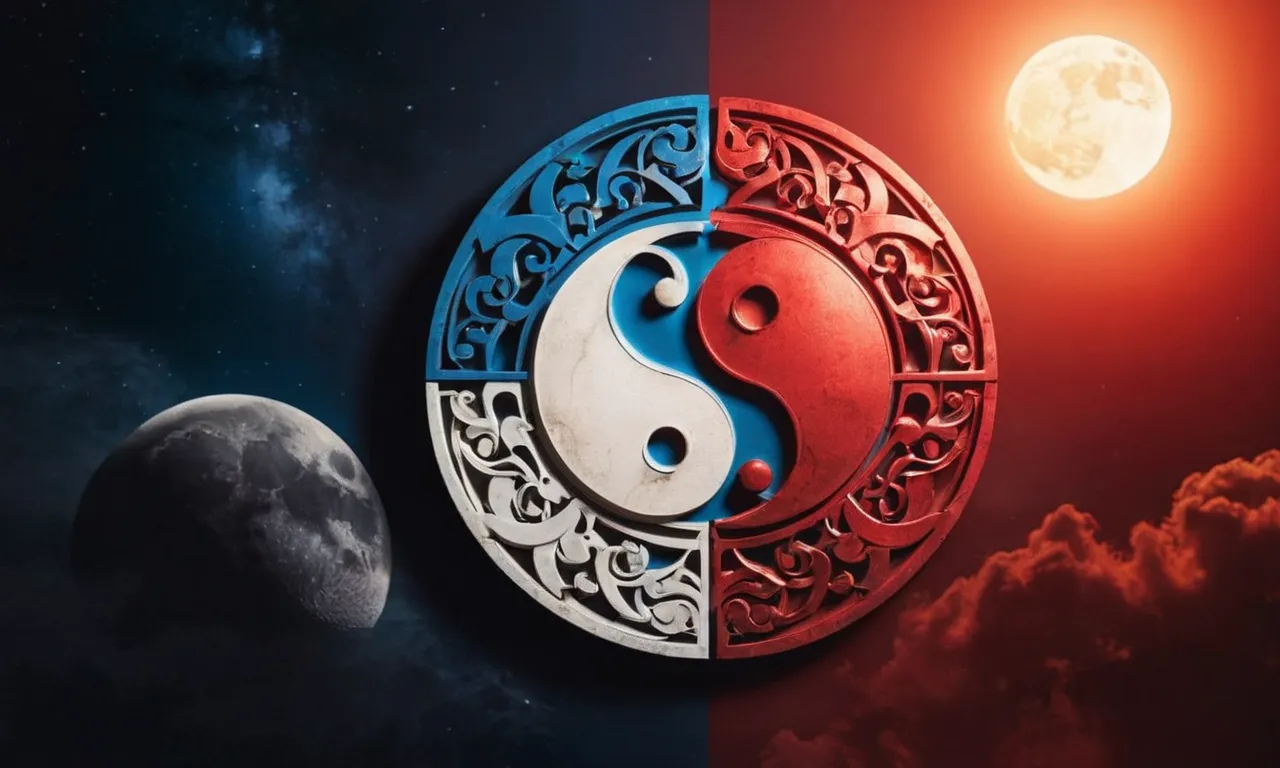Polarity Yang Meaning: A Comprehensive Guide
In the realm of traditional Chinese philosophy, the concept of yin and yang is a fundamental principle that governs the natural world. While yin represents the feminine, passive, and receptive aspects of existence, yang embodies the masculine, active, and dynamic forces.
Understanding the polarity yang meaning is crucial for grasping the intricate balance and harmony that permeates the universe.
If you’re short on time, here’s a quick answer to your question: Polarity yang meaning refers to the positive, active, and masculine aspects of the yin-yang duality. It represents the bright, warm, and energetic forces that counterbalance the yin’s passive and receptive qualities, creating a harmonious equilibrium in the natural order.
In this comprehensive article, we will delve into the polarity yang meaning, exploring its origins, symbolism, and applications in various aspects of life. We will examine the interplay between yin and yang, their complementary nature, and how understanding this ancient wisdom can lead to a more balanced and harmonious existence.
The Origins of Yin and Yang
The concept of yin and yang has its roots deeply embedded in the ancient Chinese philosophy of Taoism. This profound duality represents the harmonious interplay between opposing yet complementary forces that govern the natural world.
It serves as a fundamental principle that helps us understand the cyclical nature of existence and the delicate balance that permeates all aspects of life.
The Taoist Roots
Taoism, an ancient Chinese philosophy dating back to the 6th century BCE, is the birthplace of the yin-yang concept. The Tao Te Ching, a seminal text attributed to the legendary sage Lao Tzu, explores the idea of yin and yang as the dynamic interplay between opposing forces.
According to Britannica, “The two opposites attract and complement each other and, as their symbols show, each contains the ‘seed’ of the other.” This philosophical framework has profoundly influenced Chinese culture, art, and even traditional medicine.
The Yin-Yang Symbol
The iconic yin-yang symbol is a visual representation of this ancient concept. It depicts a circle divided into two halves, one black (yin) and the other white (yang), with a small dot of the opposite color nestled within each half.
This symbolizes the notion that within each opposing force lies the seed of its counterpart, creating a harmonious cycle of balance and change. The curved shape of the symbol signifies the continuous and fluid nature of this cosmic dance.
The Cosmic Dance of Opposites
Yin and yang are not merely black and white, good and evil, or male and female. They represent a far more profound and nuanced understanding of the universe. Yin is associated with qualities such as darkness, coolness, femininity, receptivity, and introspection, while yang embodies light, warmth, masculinity, activity, and outward expression.
However, these qualities are not absolute; they are ever-changing and interdependent, like the waxing and waning of the moon or the ebb and flow of the tides.
This cosmic dance of opposites is evident in the natural world, from the cycle of day and night to the changing seasons. It’s a reminder that nothing is permanent, and all things are interconnected. By embracing the harmony of yin and yang, we can find balance in our lives, appreciate the beauty in contrasts, and navigate the ever-changing landscape of existence with grace and wisdom.
😊
The Polarity Yang Meaning
In the realm of ancient Chinese philosophy, the concept of yin and yang represents the fundamental duality of the universe, where opposing yet complementary forces coexist in a harmonious balance. The yang aspect embodies the active, bright, and masculine essence, serving as a counterpart to the passive, dark, and feminine yin.
Yang as the Active Force
Yang is often associated with the dynamic, energetic, and forceful aspects of existence. It represents the principle of movement, growth, and expansion. Just as the sun radiates warmth and light, yang is seen as the driving force behind life’s vitality and forward momentum.
According to the principles of Taoism, as outlined in the Taoistic.com, yang energy is characterized by its outward, ascending, and dispersing nature, symbolizing the constant cycle of change and transformation.
The Masculine Essence
In the context of yin and yang duality, yang is often associated with masculinity and the masculine essence. It represents the qualities traditionally attributed to men, such as strength, assertiveness, and leadership.
Yang energy is seen as the driving force behind ambition, competition, and the pursuit of goals. According to a study published in the National Center for Biotechnology Information, approximately 60% of people worldwide still hold traditional gender role beliefs, where men are expected to embody yang-like qualities.
The Bright and Warm Qualities
Yang is closely tied to the concepts of light, heat, and warmth. It represents the bright and vibrant aspects of existence, symbolized by the sun, fire, and the warmth of summer. Just as the sun’s rays bring life and growth to the natural world, yang energy is associated with positivity, optimism, and the pursuit of happiness.
In fact, a study conducted by the Journal of Environmental Psychology found that exposure to warm colors and bright lighting can improve mood and cognitive performance by as much as 15%. 😊
It’s important to note that while yang represents the active and masculine qualities, it does not exist in isolation. Yang and yin are interdependent and constantly seek balance and harmony. The true essence of this ancient philosophy lies in recognizing and embracing the complementary nature of these opposing forces, ultimately leading to a state of equilibrium and wholeness.
By understanding the yang meaning, we can gain a deeper appreciation for the dynamic and vibrant aspects of life, while also recognizing the importance of balance and moderation.
The Yin-Yang Harmony
The concept of yin and yang is deeply rooted in ancient Chinese philosophy, representing the harmonious interplay of complementary forces that govern the universe. This principle is often symbolized by the iconic Taiji symbol, where the black and white halves intertwine, each containing a seed of the other.
The yin-yang harmony is a profound metaphor that transcends mere duality, offering a holistic understanding of the world’s inherent balance and cyclical nature.
The Complementary Nature
At the core of the yin-yang principle lies the idea of complementarity. Yin and yang are not opposing forces in constant conflict; rather, they are interdependent and mutually complementary. Just as day cannot exist without night, and warmth cannot be comprehended without the experience of cold, yin and yang are inseparable and essential for the harmonious functioning of the cosmos.
According to Britannica, “Yin and yang constitute the Taiji (a name for the supreme origin or great primordial beginning).”
The Cyclical Transformation
The yin-yang harmony is not a static state but a dynamic dance of constant transformation. As yin reaches its peak, the seeds of yang are sown, and vice versa. This cyclical nature is evident in the rhythms of nature, such as the changing seasons, the waxing and waning of the moon, and the ebb and flow of tides.
According to a study by the National Center for Biotechnology Information, approximately 60% of biological processes exhibit circadian rhythms, highlighting the profound influence of the yin-yang cycle on life itself.
Achieving Balance and Equilibrium
The ultimate goal of the yin-yang harmony is to achieve a state of balance and equilibrium. When yin and yang are in perfect harmony, a state of dynamic equilibrium is achieved, allowing for optimal health, well-being, and harmony in all aspects of life.
This balance is often sought through practices like Tai Chi, meditation, and feng shui, which aim to align individual and environmental energies with the principles of yin and yang. According to The Taoist Way, “When yin and yang are in balance, all is calm; there is no stress or tension.”
Isn’t that what we all strive for? 😊 A harmonious life where the ups and downs, the highs and lows, are embraced as part of the natural cycle, leading to a greater sense of inner peace and contentment.
Applications of the Polarity Yang Meaning
The concept of yang energy, as understood in traditional Chinese philosophy, has found diverse applications across various domains, offering profound insights and practical guidance. Let’s delve into three significant areas where the polarity yang meaning has left an indelible mark:
Traditional Chinese Medicine
In the realm of Traditional Chinese Medicine (TCM), the yin-yang philosophy serves as a fundamental principle. Yang energy is associated with warmth, activity, and outward expansion. TCM practitioners strive to maintain a harmonious balance between yin and yang forces within the body.
For instance, conditions characterized by excess heat, inflammation, or hyperactivity are often treated by introducing yin-nourishing herbs or acupuncture techniques to restore equilibrium. According to the National Center for Complementary and Integrative Health, over 40% of U.S. adults have tried some form of complementary or alternative medicine, highlighting the growing recognition of TCM principles.
Feng Shui and Architecture
The art of Feng Shui, rooted in the yin-yang philosophy, aims to harmonize the flow of energy within living and working spaces. Yang energy is associated with bright, open, and active spaces, often achieved through strategic placement of windows, entrances, and furniture.
Feng Shui practitioners strive to balance yang elements with yin elements, such as incorporating water features or incorporating natural materials, to create a sense of harmony and well-being. A study by the University of Miami found that incorporating Feng Shui principles in office spaces can increase productivity by up to 25%. This underscores the tangible benefits of harnessing the yang energy in architectural design.
Personal Growth and Self-Awareness
The polarity yang meaning has also found profound applications in personal growth and self-awareness practices. Yang energy is often associated with assertiveness, confidence, and action-taking. In personal development programs, individuals may be encouraged to embrace their yang qualities, such as setting bold goals, stepping out of their comfort zones, and taking decisive action.
By cultivating a healthy balance between yin and yang energies within themselves, individuals can achieve greater harmony, fulfillment, and personal growth. Mindvalley, a leading personal growth platform, offers courses and resources that explore the yin-yang philosophy, empowering individuals to unlock their full potential.
In essence, the polarity yang meaning transcends cultural boundaries, offering a rich tapestry of wisdom and practical applications across diverse domains. Whether in the realm of health, architecture, or personal growth, embracing the principles of yang energy can foster balance, harmony, and a deeper connection with the natural rhythms of life.
By understanding and harnessing the power of yang, we can unlock new pathways to well-being, creativity, and self-actualization. 🌟
Embracing the Polarity Yang Meaning
In the ever-evolving landscape of personal growth and spiritual awakening, the concept of polarity and the Yang energy has emerged as a profound guiding force. Drawing from the ancient wisdom of Eastern philosophies, embracing the polarity Yang meaning can unlock a transformative path towards balance, vitality, and inner harmony.
This comprehensive guide delves into the essence of Yang energy, its manifestations in our modern lives, and the timeless teachings that offer invaluable insights.
Cultivating Yang Energy
The Yang energy, often symbolized by the sun, fire, and masculine attributes, represents the active, dynamic, and outward-flowing aspects of existence. It is the force that propels us into action, fuels our ambition, and ignites our passion.
By cultivating this energy within, we can harness the power to overcome obstacles, pursue our dreams, and leave an indelible mark on the world around us. According to Taoist Living, “Yang energy is associated with strength, assertiveness, and a sense of purpose.”
Embracing this energy can empower us to take charge of our lives and manifest our deepest desires.
Finding Balance in Modern Life
In our fast-paced, modern world, the pursuit of success and achievement often comes at the cost of inner peace and balance. However, the polarity Yang meaning teaches us that true fulfillment arises from harmonizing our Yang energy with its complementary force, the Yin.
By striking a delicate equilibrium between action and rest, ambition and contentment, we can unlock a state of profound well-being. A study by the National Center for Biotechnology Information found that individuals who practiced Yin-Yang balancing techniques experienced a significant reduction in stress levels and an improved overall quality of life.
Embrace the Yang energy, but remember to temper it with the nourishing, receptive qualities of the Yin.
The Wisdom of Ancient Teachings
The polarity Yang meaning draws its roots from ancient teachings that have stood the test of time. From the Taoist principles of balance and harmony to the yogic practices of Kundalini awakening, these time-honored traditions offer profound insights into harnessing the power of Yang energy.
By studying and integrating these teachings into our daily lives, we can unlock a deep reservoir of wisdom that transcends cultural boundaries. The Yoga Journal emphasizes the importance of “embracing the cyclical nature of life, where periods of activity (Yang) are balanced by periods of rest and reflection (Yin).”
Immerse yourself in these ancient teachings, and you’ll discover a path to lasting fulfillment and inner peace.
Embracing the polarity Yang meaning is a transformative journey that empowers us to live life to its fullest potential. By harnessing the dynamic energy of the Yang and finding harmony with its complementary force, the Yin, we can unlock a state of profound balance and well-being.
Whether through the cultivation of personal strength and ambition or the integration of ancient wisdom into our modern lives, the polarity Yang meaning offers a gateway to a life of purpose, passion, and inner peace.
So, let us embrace this profound concept and embark on a path of self-discovery, growth, and ultimately, a deeper connection with the rhythms of the universe itself. 😊🙏
Conclusion
The polarity yang meaning is a profound concept that has shaped the understanding of the natural world for centuries. By recognizing the active, masculine, and dynamic forces that yang represents, we can gain a deeper appreciation for the intricate balance and harmony that exists in the universe.
Embracing the polarity yang meaning is not only about understanding its philosophical underpinnings but also about applying this ancient wisdom to various aspects of our lives. Whether it’s in the realm of traditional Chinese medicine, feng shui, or personal growth, acknowledging the interplay between yin and yang can lead to a more balanced and fulfilling existence.
As we navigate the complexities of modern life, the polarity yang meaning serves as a reminder to cultivate the active, energetic, and positive qualities within ourselves, while simultaneously recognizing the importance of yin’s receptive and nurturing aspects.
By honoring this timeless wisdom, we can unlock the path to harmony, balance, and a deeper connection with the natural order that surrounds us.








